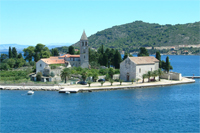 The island of Vis, known for its fishermen and seafarers, beautiful nature, olive groves and vines, ancient ruins and secluded beaches, lies far from the mainland.
The island of Vis, known for its fishermen and seafarers, beautiful nature, olive groves and vines, ancient ruins and secluded beaches, lies far from the mainland.
The Greeks founded their first colony on Vis (named Issa) and planted the first grapevine there as early as the 4th century. A Franciscan monastery was built on the remains of the Greek and Roman theatre in the small town of Vis in the 16th century. Two churches from the 16th and 17th centuries have been preserved, as well as a number of Renaissance houses.
The island of Bisevo is to the southwest of the island of Vis. Many caves have been carved into its steep coast. Among these, the Blue Cave (Modra Spilja) with entrances both above and below sea level should be singled out. When the sea is calm the light diffracts and paints the interior of the cave blue, and anything below the water line silver. The effect rivals that of the well-known cave on Capri.
On the southern side of the island is the considerably larger Medvidina cave with a natural monumental entrance. The approach corridor is 760m long and leads onto the beach, a former habitat of the now almost extinct marine mammal, the Mediterranean monk seal.
The Vis archipelago also includes the islands of Svetac (Sveti Andrija), Jabuka, Brusnik, and the islands of Palagruza.
To the west of Vis, the island of Jabuka rises like a pyramid. Its black volcanic rocks, 96m high, fall almost vertically into the depths of the sea. In the immediate vicinity of the island, the compass will deviate a little due to the island's natural magnetism. The sea around the island is rich with fish and lobsters, while black lizards – an endemic species - sunbathe on the warm rocks.